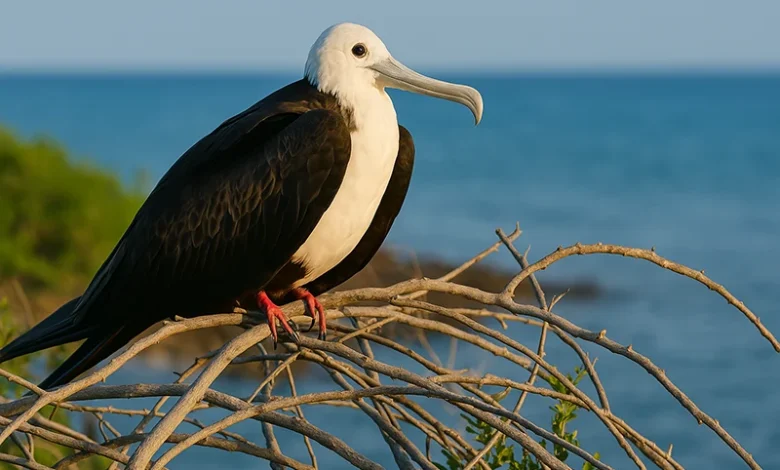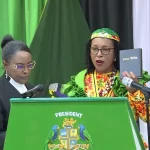Magnificent Frigatebird (female)

The Magnificent Frigatebird (Fregata magnificens) is one of the most striking seabirds found in Dominica, it is most commonly observed soaring along the west coast or roosting near offshore islets. The female of the species, distinct from the male by her white breast patch, is a familiar sight in Dominica’s coastal skies.
Appearance and Identification
The female Magnificent Frigatebird is a large seabird with an average wingspan of over 2.3 meters (7.5 feet). While males are entirely black with a red throat pouch, the female has a glossy black plumage with a contrasting white chest and a blue-gray orbital ring. Both sexes possess long, slender wings and a deeply forked tail, giving them their unmistakable silhouette in flight.
Their build allows them to glide for hours without flapping, making them one of the most aerodynamically efficient seabirds in the region.
Habitat and Sightings in Dominica
While Magnificent Frigatebirds do not breed on Dominica, females and juveniles are commonly seen:
- Over the Caribbean Sea near Roseau and Portsmouth
- Around Cabrits National Park, especially on thermals during the late morning
- Off the coast near Scotts Head and Soufrière, gliding on air currents
- Occasionally following fishing boats or storms, drifting close to shore
They are most active early in the morning or late afternoon, often gliding high overhead in loose flocks.
Behavior and Ecology
Frigatebirds feed almost exclusively on fish and squid, often stealing food from other seabirds mid-flight, a behavior known as kleptoparasitism. They are also capable of snatching prey from the ocean surface without landing—thanks to their light frame and agile wings.
The females can remain airborne for days at a time, using minimal energy while covering large distances over open water. Unlike many seabirds, they cannot land on water due to their lack of waterproofing.
Breeding and Migration
Magnificent Frigatebirds breed on remote Caribbean islands, including the Grenadines and Barbuda, but not on Dominica. The females only raise one chick every other year, and remain highly protective and nurturing during the long rearing period.
In Dominica, most sightings are of non-breeding females and juveniles, especially outside the peak breeding season.
Magnificent Frigatebird’s Local Name in Dominica
In Dominica, the Magnificent Frigatebird (Fregata magnificens) is commonly referred to by several local names, including:
- Sizo: Derived from the bird’s deeply forked tail, which resembles a pair of scissors.
- Fwégad, Frégad, or Fwégat: Variations that are likely adaptations of the word “frigate,” reflecting the bird’s common name.
- Frygate: Another phonetic variation of “frigate.”
- Scissors: Directly referencing the shape of the bird’s tail.
These names are used interchangeably among locals to describe this distinctive seabird.




